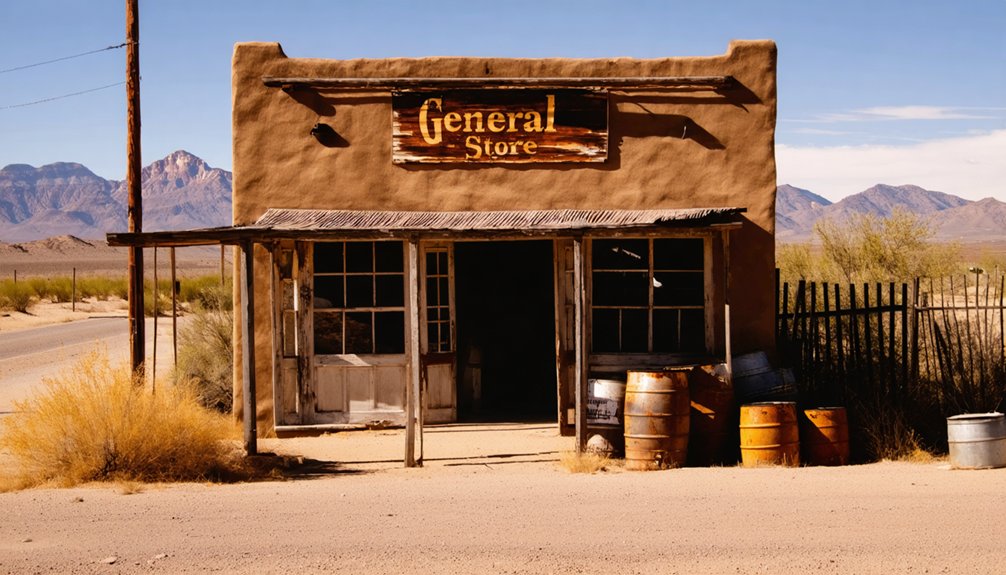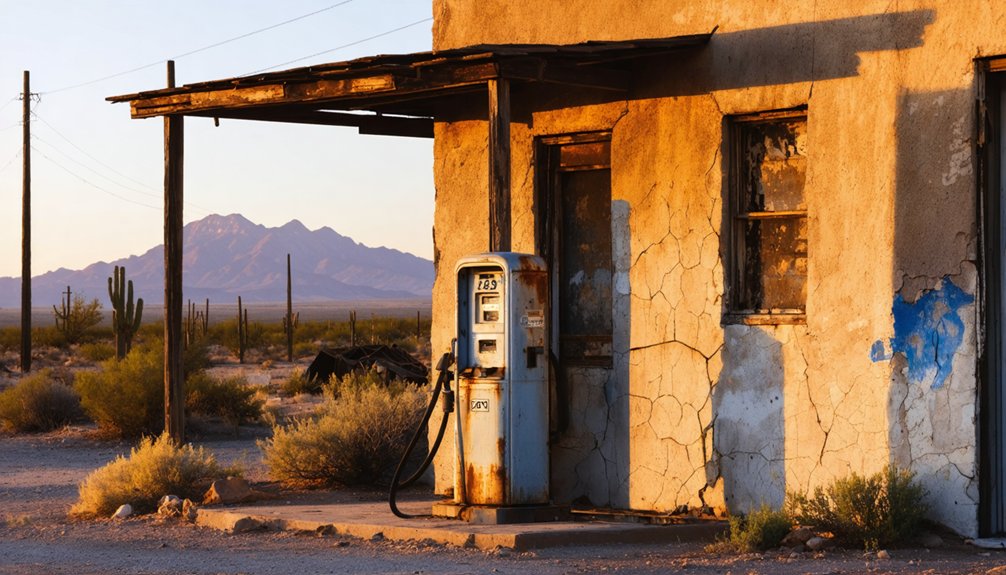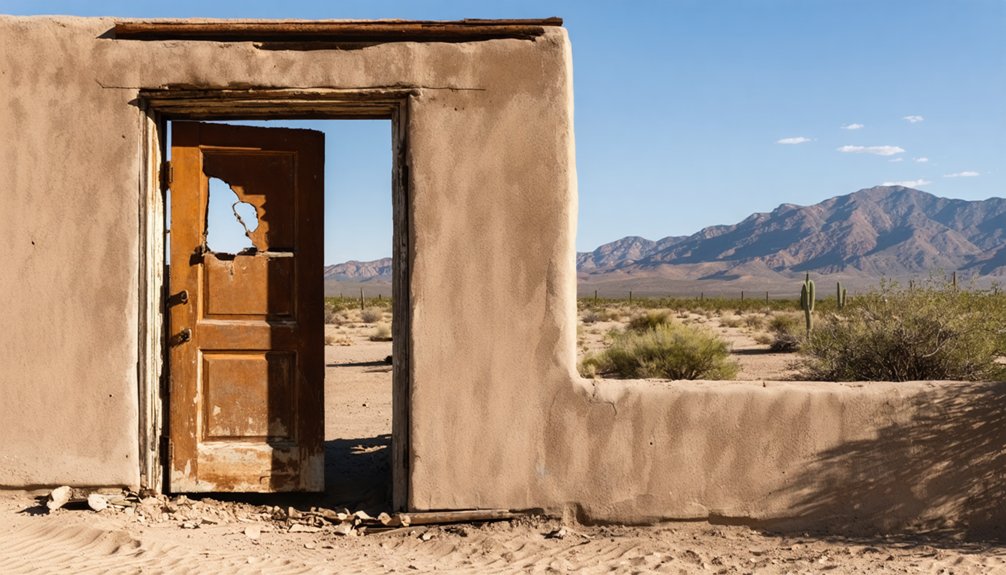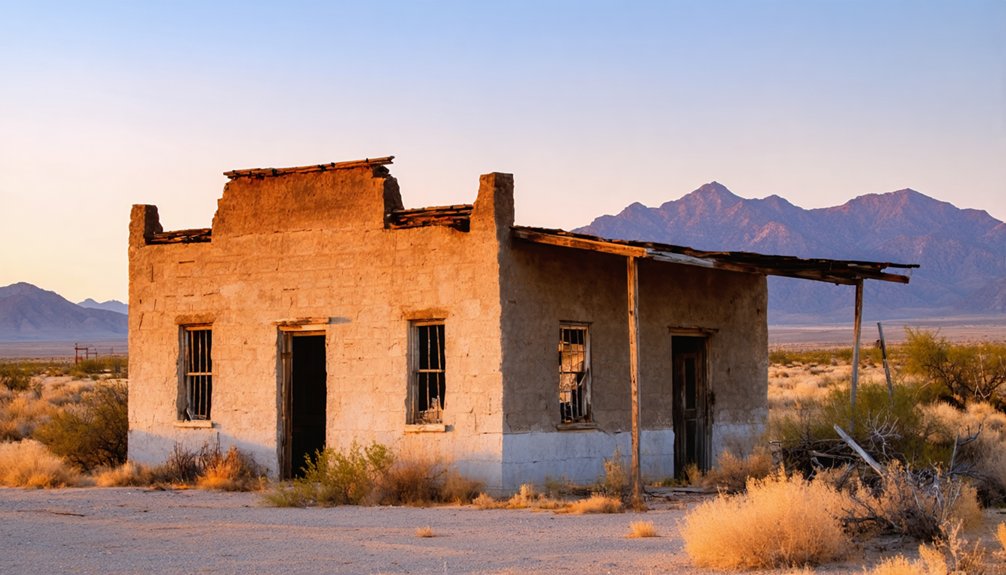You’ll find Toyahvale’s haunting ruins in West Texas, where W.T. Youngblood established a trading post in the late 1870s. The town flourished after the Texas & Pacific Railroad arrived in 1881, growing to 771 residents by 1910. As a major cattle-shipping point, it attracted both lawmen and rustlers before declining during the Great Depression. Today, the abandoned railroad hub, boarded-up high school, and weathered structures hold fascinating tales of frontier justice and untold secrets.
Key Takeaways
- Toyahvale began as a trading post in the 1870s and grew into a thriving railroad town with a peak population of 771 residents.
- The town’s strategic location near major rail lines made it a vital shipping center for cattle, grain, cotton, and cantaloupes.
- Water scarcity and economic challenges during the Great Depression led to the town’s eventual abandonment and ghost town status.
- Abandoned structures include a historic high school with boarded windows, weathered railroad facilities, and empty commercial buildings.
- The ghost town’s ruins are now popular for urban exploration, with local legends of “black-eyed children” haunting the abandoned corridors.
From Frontier Trading Post to Railroad Hub
While many frontier towns emerged from military forts or mining claims, Toyah’s story began as a humble trading post in the late 1870s when W. T. Youngblood established a tent store to serve local ranchers.
Named after an Indian word for “flowing water,” the settlement quickly became essential to isolated ranches seeking supplies.
Everything changed in 1880 when the Texas & Pacific Railroad began construction through Reeves County.
By 1881, you’d have witnessed Toyah’s dramatic transformation as section houses, a roundhouse, and railroad shops sprung up.
The town’s first train arrival that year marked its evolution from trading post to bustling rail hub, much like Palestine’s transformation when the H&GN reached it in 1873.
With a new post office and stagecoach services connecting to Fort Davis and Fort Stockton, Toyah emerged as a significant transportation nexus in West Texas’s harsh desert landscape.
The community reached its zenith in 1910 with four churches and banks serving the growing population.
The Legacy of W.T. Youngblood’s Vision
W.T. Youngblood’s 1879 arrival in Toyah marked the beginning of organized commerce when he established a tent store serving local ranchers.
The opening of a post office in 1881 transformed the small trading post into a legitimate town.
You’ll find that his initial role as a traveling peddler between ranches evolved into a permanent adobe trading post, which became the area’s first stable commercial hub.
His pioneering business vision laid the groundwork for Toyah’s transformation from a frontier outpost into a railroad town, attracting settlers and establishing critical trade routes that would shape the region’s early development.
By 1914, the growing community reached its peak with a population of over one thousand residents.
Pioneer Trading Post Origins
During the early 1880s, the pioneering spirit of W.T. Youngblood brought significant change to what would become Toyahvale.
You’ll find the trading post‘s significance rooted in his arrival by covered wagon, loaded with general merchandise that would spark early commerce in the region.
Before building his permanent adobe store, Youngblood adapted to the frontier’s challenges by peddling goods directly to scattered ranches. This practice followed the tradition of early trading posts established decades earlier in places like Navarro County.
His strategic location near Billingslea Draw positioned the trading post perfectly along key transportation routes.
The site’s name, Toyahvale, comes from an Indian word meaning “flowing water,” reflecting the area’s indigenous heritage. The town’s development was further enhanced by its position along U.S. Highway 290, which became vital to regional connectivity.
Early Railroad Town Development
The pioneering foundation laid by Youngblood’s 1879 tent store in Toyahvale proved instrumental to the town’s railway development. His adobe store became a commercial anchor, positioning the settlement for the Texas and Pacific Railway’s arrival in 1880. Similar to many Texas towns, water depots were constructed to support the vital operations of steam locomotives.
The railroad architecture soon transformed the landscape with crucial infrastructure:
- Section houses and roundhouses for locomotive maintenance
- A strategic shipping terminus serving regional ranchers
- Fundamental water facilities supporting steam engine operations
This vital rail connection supported the region’s early economic growth until passenger services ended in the late 1940s.
Rail Lines and Economic Prosperity
Since its arrival in 1881, railroad infrastructure radically transformed Toyahvale’s economic landscape and regional connectivity.
You’d have witnessed the Pecos Valley Southern Railway‘s dramatic impact as it laid 40.3 miles of track by 1910, replacing inefficient horse-and-buggy transport that had struggled in 100°F+ heat. The railway’s presence sparked immediate economic growth, enabling farmers to ship grain, cotton, cantaloupes, and cattle to distant markets.
The rail lines’ influence peaked when they connected to the Texas & Pacific main line and Santa Fe branch, creating a crucial transportation network. The community’s original post office opened 1894, marking another step in its development.
But Toyahvale’s prosperity wouldn’t last forever. By 1971, the line retreated to Saragosa, triggering economic decline. The town’s population swung wildly – from 25 to 150 residents in just one year – before settling at today’s mere 60 inhabitants.
Life in Early Toyah (1880-1910)
Established in 1879 by W.T. Youngblood, Toyah began as a humble trading post with a tent store serving local ranchers.
You’d have witnessed the cultural evolution from frontier outpost to thriving railway town after the Texas & Pacific Railway’s arrival in 1881. The community’s population swelled to 771 by 1910, transforming the landscape from scattered tents to permanent structures. The town flourished as a major cattle-shipping center, becoming vital to the region’s ranching economy.
- Community gatherings centered around saloons, the general store, and hotels where cowboys, railroad workers, and ranchers socialized.
- Churches and schools emerged by the late 1800s, marking the shift from transient to settled community life.
- The A.M. Fields Hotel served as a bustling hub for travelers, while stagecoach services connected Toyah to Fort Davis and Fort Stockton six times weekly.
Tales From the Texas Range

You’ll find Charles Siringo’s cowboy detective work in 1880s Toyah centered on tracking cattle rustlers who terrorized local ranches and challenged the emerging social order.
As a crucial railroad shipping point, Toyah’s position along the Texas & Pacific line made it a natural battleground between lawmen and outlaws, where frontier justice often played out through vigilante actions.
The town’s general store served as an informal courthouse where ranchers gathered to share intelligence about rustling activities and coordinate their responses to the persistent threats along the open range.
Cattle Rustlers Strike Back
While Texas Rangers and lawmen worked diligently to combat cattle theft in the early 1900s, rustlers constantly developed innovative methods to outsmart them.
You’ll find their rustling techniques evolved dramatically from simple open-range theft to sophisticated operations using modern technology.
Here’s how cattle rustlers adapted their methods:
- Using “running irons” to alter brands and fake ownership
- Deploying trucks for nighttime raids and quick meat transport
- Utilizing helicopters and tranquilizer darts in later decades
During WWII, you’d have witnessed a surge in cattle theft as rustlers exploited meat shortages and wartime conditions.
They’d steal cattle under cover of darkness, butcher them nearby, and sell the meat through black markets hundreds of miles away, staying ahead of law enforcement by crossing state lines.
Frontier Justice Prevails Here
During the volatile years between 1870 and 1920, frontier justice reigned supreme across the Texas borderlands as the legendary Texas Rangers fought to maintain order through swift, often controversial methods.
You’d have witnessed Leander McNelly’s elite Ranger unit tackling frontier lawlessness with aggressive tactics, conducting rapid trials and immediate punishments without formal courts.
As Mexican bandits and Villista guerrillas terrorized border towns, killing over 500 Texan civilians in 1915 alone, the Rangers responded with extrajudicial violence to restore stability.
Their quasi-military approach proved effective yet problematic, leading to a 1919 investigation that exposed illegal killings and abuses of power.
While the Rangers’ autonomy diminished through subsequent reforms, their impact on taming the wild Texas frontier had already secured their place in history.
Life Along Prairie Rails
As Texas railroads carved through the untamed prairie between 1870 and 1880, they transformed isolated frontier outposts into bustling commercial hubs through an unprecedented expansion of track and territory.
Railroad camps like “Prairie Switch” evolved into thriving towns, becoming essential centers of commerce where Mexican cowboys managed vast herds awaiting shipment to northern markets.
The prairie economy flourished as rail lines enabled rapid transport of:
- Prairie hay, making El Campo the nation’s largest shipping point
- Cattle drives culminating at strategic rail towns
- Cotton, rice, and corn reaching distant markets
You’d find life along these rails both promising and harsh.
While the railroads brought technological advances like windmills and barbed wire fencing, workers faced unpredictable weather and grueling conditions as they labored to connect Texas’s expanding frontier with the rest of America.
The Slow Fade of a Frontier Town

Once a bustling frontier outpost born from W.T. Youngblood’s humble tent store, Toyah’s decline mirrors many American frontier towns that couldn’t adapt to changing times.
You’ll find the railroad impact was double-edged – first bringing prosperity through cattle shipping and commerce, then contributing to the town’s downfall as transportation patterns evolved.
Community challenges mounted steadily through the early 1900s. You can trace Toyah’s slow fade through its dwindling population, shuttered school, and abandoned businesses.
The Great Depression dealt a particularly harsh blow, accelerating the exodus of residents seeking opportunities elsewhere.
Water scarcity, which plagued the town even in its prime, made sustainable growth impossible.
Today, you’ll see only hollow buildings and crumbling structures – silent sentinels of a once-thriving frontier community that time and progress left behind.
Abandoned Landmarks and Hidden Stories
Beyond the crumbling facade of Toyah High School, you’ll find a haunting collection of abandoned landmarks that tell stories of the town’s dramatic decline. The empty corridors and shattered windows have spawned haunted legends of “black-eyed children” who roam at night, while the deserted fire station and scattered homes stand as silent witnesses to a once-thriving community.
Popular spots for urban exploration include:
- The railroad hub’s weathered remnants, including the old roundhouse and repair shops
- The historic high school with its overgrown playground and boarded windows
- Former commercial buildings that once served the cattle shipping industry
These decaying structures aren’t just empty shells – they’re portals to Toyah’s turbulent past, from violent shootouts to the mysterious circumstances that led to its abandonment.
Each building holds secrets of a frontier town’s rise and fall.
Exploring Today’s Ghost Town Ruins

While Toyahvale and Toyah are often confused, it’s the latter that stands today as a haunting collection of weathered ruins, with just 61 residents remaining as of 2020.
As you explore the deserted streets, you’ll encounter haunted structures like the tornado-damaged bank with its broken columns and the crumbling 1912 brick schoolhouse that once bustled with students.
The eerie atmosphere intensifies as you discover abandoned railroad buildings from the 1880s, including section houses and the old roundhouse.
You’ll find W.T. Youngblood’s deteriorating adobe store, where ranchers once gathered, and scattered remnants of hotels and saloons.
The 2004 tornado accelerated Toyah’s transformation into a ghost town, leaving behind a stark reminder of West Texas’s boom-and-bust cycles.
Frequently Asked Questions
Are There Any Documented Supernatural Occurrences in Toyah’s Abandoned Buildings?
Ever wonder what lurks in those empty halls? You’ll find documented supernatural sightings of mysterious orbs, “black-eyed children,” and shadowy figures, with ghostly legends backed by visitors’ accounts of health issues.
What Happened to the Original Native American Inhabitants of the Toyah Area?
You’ll find Native American history in Toyah’s tribes faced displacement, disease, and cultural disruption after European contact. Their cultural heritage faded as they were absorbed into other groups or forced to migrate.
How Did Local Families Cope With Extreme Weather Conditions?
Like desert chameleons, you’d adapt to survive harsh conditions through shared family practices – building adobe homes, storing water in cisterns, preserving food, and timing daily activities around extreme temperatures.
Which Original Buildings From 1879 Still Remain Standing Today?
You won’t find any original 1879 buildings standing today, despite historic preservation efforts. While architectural significance remains through later structures like the 1912 school, the earliest adobe buildings haven’t survived.
Did Any Famous Outlaws or Gunfighters Ever Pass Through Toyah?
While millions dreamed of famous outlaws roaming Toyah, you’ll find only cowboy-detective Charles Siringo confirmed there in 1882. No legendary gunfighters like Billy the Kid ever visited this frontier town.
References
- https://www.legendsofamerica.com/toyah-texas/
- https://www.youtube.com/watch?v=K2Cz8xmo26U
- https://mansfieldphoto.com/small-towns-of-texas/toyah-texas-ghost-town/
- https://photos.legendsofamerica.com/toyah-texas
- https://en.wikipedia.org/wiki/List_of_ghost_towns_in_Texas
- https://theforgottensouth.com/toyah-texas-ghost-town/
- https://mansfieldphoto.com/journal/7-texas-ghost-towns/
- https://www.texasescapes.com/TOWNS/Toyah_Texas/Toyah_Texas.htm
- http://txrrhistory.com/towers/173/173.htm
- https://ttarchive.com/Library/Articles/MEFSE_Historical.html



